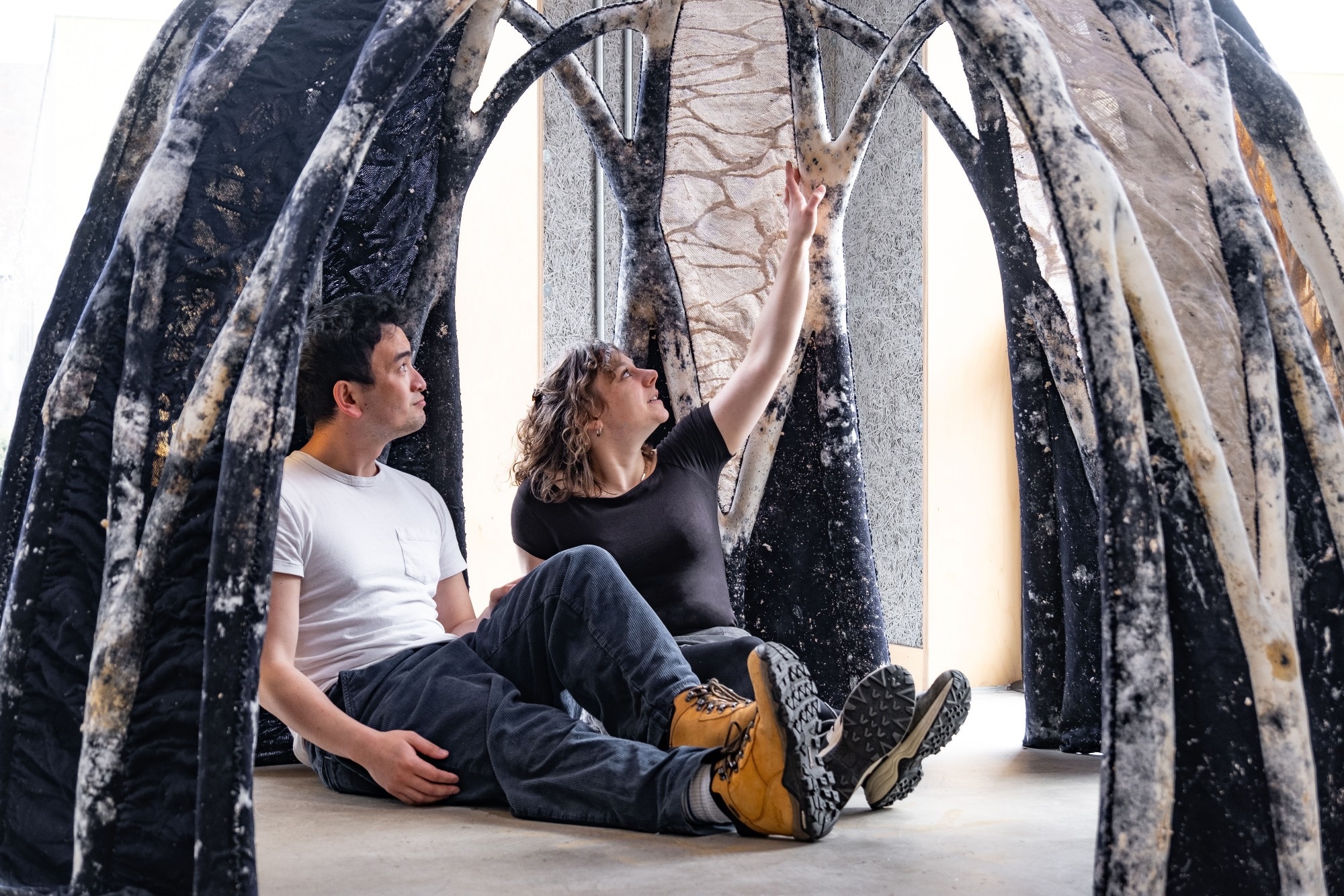Mycocrete, a paste created from the mycelium, the fungus’ root system, has been created by scientists as a building material. Injecting this into a knitted textile framework produces a composite material that is stronger and more adaptable than previous biomaterials produced by fungus and could one day be utilized to create light, environmentally friendly structures.
 Image courtesy of the Hub for Biotechnology in the Built Environment.
Image courtesy of the Hub for Biotechnology in the Built Environment.
Scientists have discovered a way to create building materials using interwoven molds and the root system of fungus in an effort to lessen the environmental impact of the construction sector.
Although similar composites have been the subject of previous research, the organic material’s structure and growth restrictions have made it challenging to create a variety of uses that fully exploit its potential.
The scientists developed a composite material called “mycocrete” using the knitted molds as a flexible framework or “formwork” that is stronger and more versatile in terms of shape and form. This allows scientists to develop lightweight construction materials that are reasonably eco-friendly.
Our ambition is to transform the look, feel, and wellbeing of architectural spaces using mycelium in combination with biobased materials such as wool, sawdust, and cellulose.”
Dr Jane Scott, Study Corresponding Author and Postdoctoral Research Fellow, Newcastle University
A group of scientists, engineers, and designers from Newcastle University’s Living Textiles Research Group, which is a component of the Hub for Biotechnology in the Built Environment and is supported by Research England, carried out the study.
Root Networks
Scientists combine mycelium spores with materials that they can grow on and feed on to create composites using this component of the fungi’s root system. For the mycelium to develop and firmly bond the substrate together, this mixture is packed into a mold and placed in a warm, humid, and dark environment.
It dries out once it reaches the proper density, but before it begins to form the fruiting bodies known as mushrooms. This method might offer an affordable, environmentally friendly alternative to foam, timber, and plastic.
However, since mycelium requires oxygen to develop, standard rigid molds are limited in size and shape, which also has an impact on the existing range of uses.
A potential solution is provided by knitted textiles, which can be used to create molds that can shift from flexible to stiff as the mycelium expands. However, fabrics sometimes have too much give, making it challenging to stuff the molds consistently.
To fully utilize the potential of knitted forms, Scott and her colleagues set out to create a mycelium combination and a production method.
Scott added, “Knitting is an incredibly versatile 3D manufacturing system. It is lightweight, flexible, and formable. The major advantage of knitting technology compared to other textile processes is the ability to knit 3D structures and forms with no seams and no waste.”
The researchers created samples of traditional mycelium composite as controls and grew them alongside samples of mycocrete, which also included water, glycerin, xanthan gum, paper powder, and paper fiber clumps.
To increase packing consistency, this paste was made to be injected into the knitted formwork using an injection gun; it had to be liquid enough to work with the delivery system but not too liquid to lose its shape.
To ensure that changes in fabric tension would not affect the performance of the mycocrete, the tubes for its intended test construction were knitted from merino yarn, disinfected, and fastened to a sturdy structure while they were filled with the paste.
Building the Future
Samples were put through tension, compression, and flexion strength testing after drying. The mycocrete samples outperformed mycelium composites grown without knitted formwork and were stronger than standard mycelium composite samples.
Additionally, the samples grown in the formwork’s porous knitted fabric had greater oxygen accessibility, and when they were dried, the samples shrank less than most mycelium composite materials do, indicating that more consistent and predictable manufacturing results could be possible.
The flexible knitted form allowed the researchers to develop a larger proof-of-concept prototype structure called BioKnit, a complicated freestanding dome built in a single piece without seams that could end up being weak places.
Scott concluded, “The mechanical performance of the mycocrete used in combination with permanent knitted formwork is a significant result, and a step towards the use of mycelium and textile biohybrids within construction. In this paper we have specified particular yarns, substrates, and mycelium necessary to achieve a specific goal. However, there is extensive opportunity to adapt this formulation for different applications. Biofabricated architecture may require new machine technology to move textiles into the construction sector.”
Source:
Journal reference:
Kaiser, R., et al. (2023). BioKnit: development of mycelium paste for use with permanent textile formwork. Frontiers in Bioengineering and Biotechnology. doi.org/10.3389/fbioe.2023.1229693